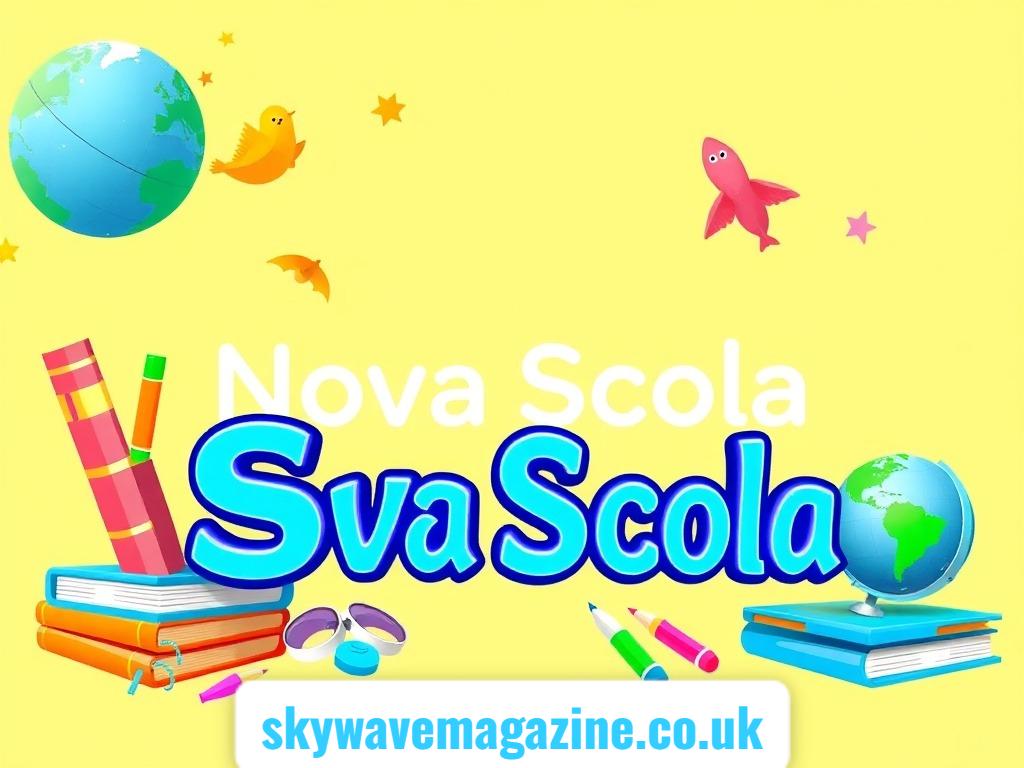
Introduction – A New Era in Learning
In the rapidly evolving landscape of global education, the concept of Nova Scola emerges as a transformative approach designed to meet the learning needs of the modern age. The name itself, derived from Latin meaning “New School,” represents more than just a fresh label for educational institutions—it signifies a revolutionary shift in how knowledge is acquired, shared, and applied. With society undergoing massive technological advancements, economic restructuring, and cultural changes, traditional schooling methods are increasingly under scrutiny for their inability to keep pace with the demands of the future. Nova Scola steps into this gap, introducing a learning paradigm that embraces flexibility, inclusivity, and technology-driven innovation. In 2025 and beyond, this model is becoming not just a preference, but a necessity for students, educators, and policymakers who wish to equip the next generation for success in an interconnected and rapidly changing world.
What Is Nova Scola?
Nova Scola is not simply a school with modern gadgets or an upgraded curriculum; it is a complete rethinking of what education should look like in the 21st century. It breaks away from the rigid structures of traditional schooling, where rote memorization, fixed schedules, and standardized testing dominate the learning experience. Instead, Nova Scola embraces a learner-centered approach, allowing students to explore their unique interests, develop critical thinking skills, and engage in collaborative problem-solving. It leverages technology, project-based learning, and real-world applications to ensure that education is not only relevant but also deeply engaging. While traditional schools often focus on delivering pre-set information, Nova Scola focuses on fostering curiosity, adaptability, and lifelong learning habits—skills that are increasingly valuable in today’s competitive global economy.
The Vision Behind Nova Scola
The vision of Nova Scola is grounded in the belief that education should prepare learners for more than just academic achievement—it should prepare them for life. This involves nurturing creativity, emotional intelligence, social awareness, and ethical responsibility alongside intellectual growth. The founders and proponents of Nova Scola believe that every learner has unique strengths and potential, and that education should provide the tools, resources, and guidance needed to unlock these abilities. This vision also aligns with the global push towards Education 4.0, a model that integrates digital tools, collaborative learning, and real-world problem-solving into the fabric of the educational experience. Nova Scola aspires to be an inclusive system that can adapt to cultural differences, economic realities, and the diverse learning needs of communities worldwide.
Key Features of Nova Scola
Nova Scola is characterized by a set of core principles and features that differentiate it from traditional schooling models:
Student-Centered Learning
In Nova Scola, the learner takes the central role in the education process. Rather than following a one-size-fits-all curriculum, students can tailor their learning paths according to their strengths, interests, and career goals. Teachers act more as mentors and facilitators than mere providers of information.
Technology-Driven Education
Digital platforms, artificial intelligence, and interactive tools play a critical role in Nova Scola’s operations. Learning is supported through online resources, virtual classrooms, adaptive learning software, and gamified experiences that make the process more engaging and effective.
Inclusive and Accessible Learning
Nova Scola emphasizes equity and accessibility, ensuring that learners of all backgrounds, abilities, and economic statuses can benefit from its model. This may include multilingual content, special education support, and affordable learning technologies.
How Nova Scola Works in Practice
In a Nova Scola environment, the classroom is not limited to four walls. Students may work on collaborative projects with peers across the globe, participate in real-world internships, or develop entrepreneurial ventures as part of their learning experience. Lessons are often structured around themes or real-life challenges rather than isolated subjects, allowing for interdisciplinary learning. Assessments focus more on skill application and portfolio development than on standardized tests. Educators facilitate discussions, guide research, and provide personalized feedback rather than simply delivering lectures. The entire approach is designed to empower students to take ownership of their education while also developing the critical skills they will need in life and work.
Benefits of the Nova Scola Approach
The Nova Scola model offers numerous advantages for both learners and educators. Some of the most significant include:
- Enhanced Engagement – Students are more motivated because learning is relevant to their interests and goals.
- Future-Ready Skills – Critical thinking, creativity, problem-solving, and adaptability are at the heart of the curriculum.
- Global Networking Opportunities – Collaboration with peers and experts from around the world enriches the learning experience.
- Personalized Learning Paths – Technology enables tailored learning plans to match each student’s needs.
- Real-World Application – Projects and problem-solving exercises prepare students for real-life challenges.
Challenges Facing Nova Scola
Despite its many benefits, Nova Scola faces several challenges that need to be addressed for widespread adoption. One of the biggest is resistance from traditional educational systems that are deeply rooted in standardized testing and rigid curricula. There are also concerns about the cost of implementing advanced technology in schools, particularly in underfunded regions. Another challenge lies in training educators to adapt to this new teaching model, as it requires a shift from being a knowledge authority to being a learning facilitator. Furthermore, there are debates around how to measure success in such a flexible, student-driven environment, as traditional metrics may not adequately capture the skills and competencies Nova Scola aims to develop.
Nova Scola vs Traditional Education
Below is a comparison that highlights the differences between the Nova Scola model and traditional education systems:
| Feature | Nova Scola | Traditional Education |
| Learning Approach | Student-centered, personalized | Teacher-centered, standardized |
| Curriculum | Flexible, adaptive | Fixed, uniform |
| Assessment | Portfolio, project-based | Exams, tests |
| Technology Use | High integration | Limited integration |
| Global Collaboration | Core feature | Rare |
| Real-World Application | Strong emphasis | Minimal emphasis |
This comparison shows that while traditional education provides structure and stability, Nova Scola offers flexibility, relevance, and adaptability that are better suited to today’s dynamic world.
Nova Scola’s Use of Technology
Technology is at the core of Nova Scola’s success:
Digital Learning Platforms
Students access a wealth of resources online, from interactive lessons to simulations and global knowledge databases.
AI and Adaptive Learning
Artificial intelligence tools analyze each learner’s progress and suggest tailored resources to improve understanding.
Virtual Classrooms & Collaboration
Video conferencing, shared workspaces, and global discussion boards enable learning without geographical boundaries.
Nova Scola and Global Education Trends
Nova Scola aligns with several key global education trends, including personalized learning, competency-based education, and lifelong learning. As remote work and digital collaboration become more common, education systems worldwide are under pressure to produce graduates who can adapt quickly and think critically. Nova Scola’s model is particularly well-suited to meet these demands, making it a strong contender for the future of education worldwide.
Real-World Examples of Nova Scola in Action
Many schools and educational organizations are already adopting Nova Scola principles. For example, some institutions in Finland, Singapore, and Canada have integrated project-based learning and interdisciplinary studies, similar to Nova Scola’s vision. In Brazil, certain community-based schools have adopted technology-driven and student-led learning models that reflect Nova Scola’s inclusive approach. These early adopters are reporting increased student engagement, better problem-solving abilities, and improved collaboration skills.
The Future of Nova Scola
Looking ahead, Nova Scola could redefine how society views education. Over the next decade, we can expect to see hybrid models that blend physical and virtual learning spaces, increased collaboration between schools and industries, and greater emphasis on soft skills alongside technical expertise. If adopted widely, Nova Scola could help bridge the skills gap that currently exists between education and the workplace, ensuring that students are better prepared for the challenges and opportunities of the future.
Conclusion – Why Nova Scola Matters
Nova Scola represents more than just a new educational trend—it’s a bold reimagining of what learning should be in the 21st century. By focusing on student-centered approaches, leveraging technology, and prioritizing real-world relevance, it offers a path toward a more equitable, engaging, and future-ready education system. While challenges remain in scaling and implementing this model globally, its potential to transform lives and societies is undeniable. As the world continues to change at an unprecedented pace, the need for such innovative educational frameworks will only grow stronger.
FAQs
1. What makes Nova Scola different from traditional schools?
Nova Scola prioritizes personalized, technology-driven, and student-centered learning over standardized, one-size-fits-all approaches.
2. Can Nova Scola be implemented in all countries?
Yes, but it requires adapting to local cultural, economic, and technological realities to be truly effective.
3. How does technology enhance Nova Scola learning methods?
It enables personalized learning, global collaboration, and access to vast digital resources that make education more engaging and effective.




